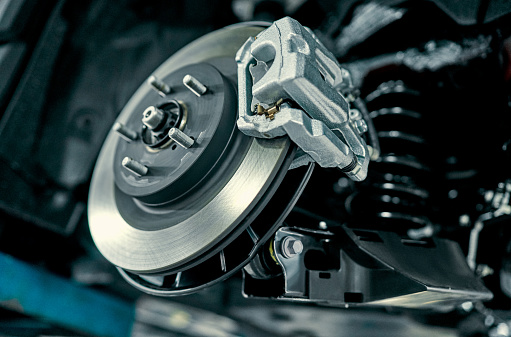March 5, 2025
STEERING SYSTEM MAINTENANCE
The steering system of a vehicle is a critical component that needs to be maintained regularly to ensure safe and reliable operation. Here are some tips for steering system maintenance:
- Check the power steering fluid level: The power steering system relies on hydraulic fluid to function properly. Check the fluid level regularly and add more as needed.
- Inspect the steering rack: The steering rack is the part of the steering system that converts the rotational motion of the steering wheel into the lateral motion of the wheels. Check for any leaks, cracks or damage to the rack.
- Check the tie rods: The tie rods connect the steering rack to the wheels. Make sure they are properly lubricated and not worn or damaged.
- Inspect the ball joints: The ball joints connect the control arms to the steering knuckles. Check for any wear or damage, and replace as needed.
- Check the alignment: A misaligned vehicle can cause uneven tire wear, poor handling, and reduced fuel efficiency. Have the alignment checked and adjusted as needed.
- Inspect the steering pump and hoses: The power steering pump and hoses can leak or become damaged over time. Check them for any signs of wear or damage, and replace as needed.
- Listen for unusual sounds: A knocking or clunking sound when turning can indicate a problem with the steering system. Have it inspected by a qualified mechanic.
- Regularly replace the power steering fluid: Over time, the power steering fluid can become contaminated or break down. It’s recommended to replace it every 50,000 miles.
By following these tips, you can help ensure that your vehicle’s steering system remains in good condition and safe to operate.
How do you maintain a steering system?
To maintain a steering system, you should follow these steps:
- Check the power steering fluid level: The power steering system relies on hydraulic fluid to function properly. Check the fluid level regularly and add more as needed.
- Inspect the steering rack: The steering rack is the part of the steering system that converts the rotational motion of the steering wheel into the lateral motion of the wheels. Check for any leaks, cracks, or damage to the rack.
- Check the tie rods: The tie rods connect the steering rack to the wheels. Make sure they are properly lubricated and not worn or damaged.
- Inspect the ball joints: The ball joints connect the control arms to the steering knuckles. Check for any wear or damage and replace them as needed.
- Check the alignment: A misaligned vehicle can cause uneven tire wear, poor handling, and reduced fuel efficiency. Have the alignment checked and adjusted as needed.
- Inspect the steering pump and hoses: The power steering pump and hoses can leak or become damaged over time. Check them for any signs of wear or damage, and replace them as needed.
- Listen for unusual sounds: A knocking or clunking sound when turning can indicate a problem with the steering system. Have it inspected by a qualified mechanic.
- Regularly replace the power steering fluid: Over time, the power steering fluid can become contaminated or break down. It’s recommended to replace it every 50,000 miles.
By following these steps, you can help ensure that your vehicle’s steering system remains in good condition and safe to operate. Additionally, it’s always a good idea to have your vehicle inspected by a qualified mechanic on a regular basis to catch any potential issues before they become major problems.
What type of maintenance is power steering likely to need?
Power steering maintenance can involve a variety of tasks, including:
- Checking the power steering fluid level: The power steering system relies on hydraulic fluid to function properly, so it’s important to check the fluid level regularly and add more as needed.
- Flushing the power steering fluid: Over time, power steering fluid can become contaminated with debris and lose its effectiveness. Flushing the power steering system and replacing the fluid can help restore proper function.
- Replacing the power steering pump: If the power steering pump is leaking or not functioning properly, it may need to be replaced.
- Checking the power steering hoses: Power steering hoses can develop leaks or become damaged over time, so it’s important to check them regularly and replace them as needed.
- Inspecting the power steering belt: If the power steering belt is worn or damaged, it can cause the power steering system to malfunction. Checking and replacing the belt as needed can help prevent problems.
- Inspecting the power steering rack and pinion: The power steering rack and pinion can wear out or become damaged, which can cause steering problems. Regular inspections can help catch these issues early and prevent more serious problems down the road.
Overall, regular maintenance is important to ensure the proper function of the power steering system and to prevent more serious issues from developing. It’s important to follow the manufacturer’s recommended maintenance schedule and to have any problems addressed promptly by a qualified mechanic.
What causes steering problems?
There are several potential causes of steering problems, including:
- Misaligned wheels: When the wheels are not properly aligned, it can cause uneven tire wear, reduced fuel efficiency, and poor handling.
- Low power steering fluid: The power steering system relies on hydraulic fluid to function properly, so if the fluid level is low, it can cause difficulty in steering or a loss of power steering altogether.
- Worn steering components: Over time, components such as tie rods, ball joints, and steering rack and pinion can wear out, which can cause steering problems such as a loose or unresponsive steering wheel.
- Damaged steering components: Damage to steering components can also cause problems with steering, such as if the steering rack is damaged or if the power steering pump or hoses are leaking.
- Tire problems: Issues such as worn or improperly inflated tires, or a damaged wheel, can cause steering problems such as vibrations or pulling to one side.
- Suspension problems: Problems with the suspension system, such as worn shock absorbers or struts, can also affect the steering and handling of the vehicle.
- Electrical issues: Problems with the electrical system, such as a malfunctioning power steering control module or sensors, can also cause steering problems.
It’s important to have any steering problems diagnosed and addressed promptly by a qualified mechanic to ensure the safe operation of the vehicle.
Does power steering need maintenance?
Yes, power steering does require maintenance to keep it functioning properly. Here are some key maintenance tasks:
-
Check Power Steering Fluid – Low or dirty fluid can cause steering problems. Check the level regularly and top it off if needed. If the fluid is dark or has debris, it may need to be flushed.
-
Flush the System – Over time, power steering fluid can degrade. Most manufacturers recommend flushing the system every 50,000–100,000 miles, but check your owner’s manual for specific intervals.
-
Inspect for Leaks – Power steering systems use hydraulic pressure, and leaks in hoses, seals, or the pump can lead to difficulty steering. Look for signs of fluid under your car or a whining noise when turning.
-
Check the Belt – If your car has a belt-driven power steering pump, inspect the belt for cracks, wear, or looseness. A worn-out belt can lead to poor steering performance.
-
Listen for Noises – Whining, groaning, or squealing when turning the wheel could indicate low fluid, air in the system, or a failing pump.
-
Steering Feel – If the steering feels too stiff or too loose, there could be an issue with the pump, rack, or linkage that needs attention.


